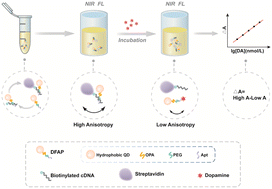NIR quantum dot construction of a fluorescence anisotropy signal amplification biosensor for sensitive, rapid and separation-free detection of dopamine in serum†
Abstract
Dopamine (DA) is an important small-molecule neurotransmitter, which is closely related to the development of many neurological diseases and has received increasing attention in the diagnosis of neurological diseases. Currently, the assays of the detection of dopamine such as electrochemical and colorimetric methods have low sensitivity, poor selectivity and susceptibility to interference, which limit the accurate quantification of dopamine. Fluorescence anisotropy immunoassay is a traditional analytical method in which the quantification is based on the change in fluorescence anisotropy values observed when fluorescence molecules are bound to a certain volume and mass of the material. Since dopamine is a small molecule with small volume and mass, we took advantage of the good photostability of the second near-infrared window (NIR-II) quantum dots (QDs) and the low spontaneous interference of the substrate, and designed a biosensor dopamine fluorescence anisotropy probe streptavidin biosensor (DFAP-SAB) based on the NIR-II QDs combined with streptavidin signal amplification to achieve rapid and separation-free detection of dopamine in human serum. The detection signal has a good linearity between 50 nM and 3000 nM with a detection limit of 11.2 nM. The application of NIR-II QDs provides the possibility of biosensor applications for complex samples. The construction of the streptavidin signal amplification device provides a new idea for small molecule detection.



 Please wait while we load your content...
Please wait while we load your content...